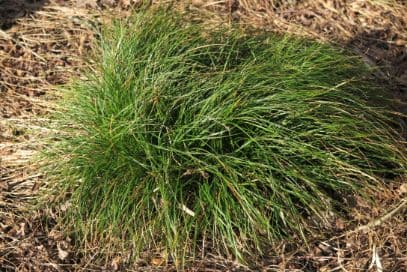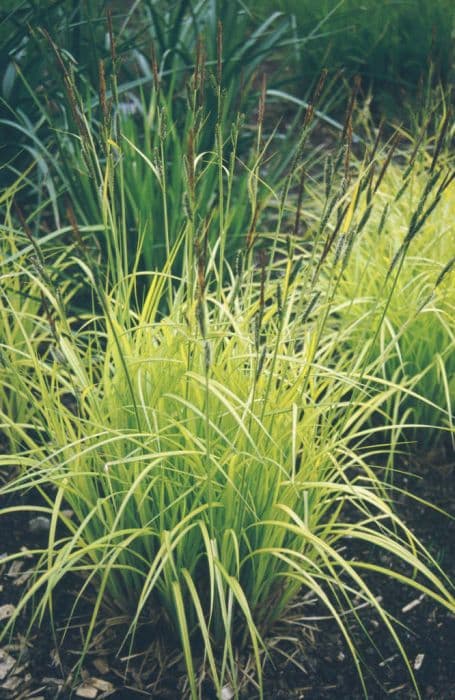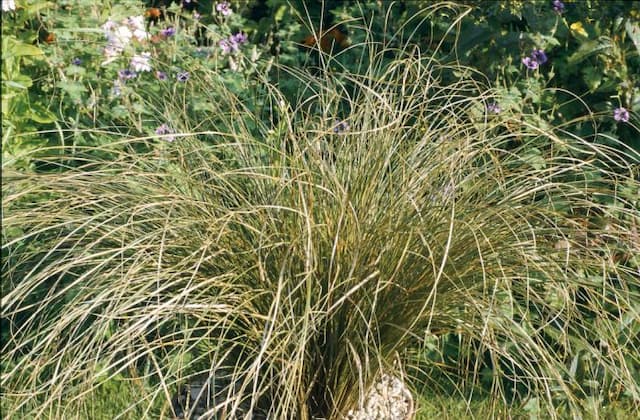Dwarf Papyrus Cyperus papyrus 'Nanus'

ABOUT
The dwarf papyrus, known as 'Nanus', is a smaller cultivar of the standard papyrus plant traditionally associated with ancient Egypt. It has a distinctive appearance characterized by bright green, grass-like, clumping foliage that resembles tufts of tall grass. Its leaves are narrow and thread-like, cascading outwards in a graceful, arching pattern from the top of the stout, triangular stems that are a trademark feature of papyrus plants. Atop these stems, the dwarf papyrus showcases an umbrella-like cluster of thread-like rays which emit from a central point, creating a spray of green bristles that are actually modified leaves. These unique clusters are termed "inflorescences," from which the actual tiny flowers of the plant emerge, although the flowers themselves are not particularly showy. The overall appearance of the dwarf papyrus is one of a lush, exotic greenery that adds a touch of tropical elegance to any setting in which it is placed. Despite being smaller than the typical variety, this plant still carries the same visual impact, with its strikingly feathery plumes and dense foliage being quite eye-catching and appealing.
About this plant
 Names
NamesFamily
Cyperaceae
Synonyms
Dwarf Papyrus, Miniature Papyrus Grass, Pygmy Papyrus, Dwarf Egyptian Papyrus
Common names
Cyperus papyrus 'Nanus'.
 Toxicity
ToxicityTo humans
Dwarf papyrus is not considered toxic to humans. Consequently, if ingested, it is not expected to cause any significant symptoms of poisoning. Despite its non-toxicity, it's not advised to consume any part of ornamental plants due to potential digestive discomfort.
To pets
Dwarf papyrus is also not considered toxic to pets. It should not cause any symptoms of poisoning if ingested by animals like cats and dogs. However, as with humans, the ingestion of non-food plants can sometimes lead to mild gastrointestinal irritation.
 Characteristics
CharacteristicsLife cycle
Perennials
Foliage type
Evergreen
Color of leaves
Green
Height
2-3 feet (60-90 cm)
Spread
2-3 feet (60-90 cm)
Plant type
Herb
Hardiness zones
9
Native area
Africa
Benefits
 General Benefits
General Benefits- Ornamental Value: Adds aesthetic interest to water gardens, pond areas, and container gardens with its unique, upright form.
- Wildlife Habitat: Provides shelter and breeding grounds for various species of birds and aquatic life.
- Soil Erosion Control: The extensive root system can help stabilize soil in wetland areas, reducing erosion.
- Water Features: Essential component for creating natural-looking water features within a landscape design.
- Educational Interest: Offers educational opportunities to learn about ancient Egyptian uses and wetland ecology.
- Adaptability: Tolerates a range of wet soil conditions, making it a versatile plant for different landscape needs.
- Cultural Heritage: Has historical significance and connections to ancient Egyptian culture, where it was used for making papyrus paper.
 Medical Properties
Medical Properties- There is not enough substantive evidence regarding the medicinal use of Cyperus papyrus 'Nanus' to provide a list of its properties. Therefore, this plant is not used for medical purposes.
 Air-purifying Qualities
Air-purifying QualitiesThis plant is not specifically known for air purifying qualities.
 Other Uses
Other Uses- Artistic Papermaking: The dwarf papyrus can be used for making high-quality, textured handmade paper that artists might prefer for its unique aesthetic.
- Craft Material: The stems can be used as a natural crafting material, ideal for weaving into decorative items like baskets or mats.
- Themed Gardens: Dwarf papyrus adds an Egyptian theme to gardens, reflecting its historical significance in the region's ancient culture.
- Model Making: Due to its scale-like appearance when cut, it can be used in model making to simulate thatched roofs or other textured surfaces.
- Biodegradable Plant Stakes: Its sturdy stems can be used as biodegradable stakes for supporting other plants in the garden.
- Floral Arrangements: The distinct look of the dwarf papyrus can add a dramatic flair to floral arrangements and bouquets.
- Water Features: It can be utilized to create a natural filtration system in water features due to its root structure's ability to absorb excess nutrients.
- Education: The plant can be used as an educational tool to teach about ancient Egyptian culture and their early methods of record-keeping through papyrus sheets.
- Water Garden Borders: It can be planted along the borders of water gardens to add structure and contrast to the aquatic landscape.
- Pond Ecosystems: Dwarf papyrus acts as a habitat for pond wildlife, offering shelter and breeding grounds for various aquatic creatures.
Interesting Facts
 Feng Shui
Feng ShuiThe Dwarf Papyrus is not used in Feng Shui practice.
 Zodiac Sign Compitability
Zodiac Sign CompitabilityThe Dwarf Papyrus is not used in astrology practice.
 Plant Symbolism
Plant Symbolism- Knowledge and Learning: As the ancient material for paper, Papyrus is closely associated with the recording and dissemination of knowledge.
- Egyptian Heritage: Papyrus is iconic of Egyptian culture where it was extensively used, symbolizing the country's ancient heritage.
- Growth and Vitality: The lush, verdant growth of the Papyrus plant represents vitality and the thriving of life.
- Connection with Water: Papyrus grows in and near water, symbolizing adaptability and the importance of water as a life source.
 Water
WaterDwarf Papyrus prefers consistent moisture, so it should be watered thoroughly whenever the top inch of soil begins to feel dry to the touch. Generally, this could mean watering once or twice a week, but frequency will vary depending on temperature and light conditions. Submerge the plant's pot in a container filled with a few inches of water, allowing the soil to absorb moisture from the bottom up for about an hour. Ensure that it receives a total of approximately one to two gallons of water per week, depending on the size of the plant and environmental conditions.
 Light
LightDwarf Papyrus thrives best in bright, indirect sunlight. An ideal spot would be near a window that receives ample sunlight throughout the day without direct exposure, which could scorch its leaves. If the indoor light is too dim, supplement it with grow lights to mimic natural light conditions.
 Temperature
TemperatureDwarf Papyrus does well in temperatures ranging from 60 to 90 degrees Fahrenheit. It is not frost-hardy, so it should not be exposed to temperatures below 50 degrees Fahrenheit. The ideal temperature range for promoting healthy growth is between 70 and 80 degrees Fahrenheit.
 Pruning
PruningPruning Dwarf Papyrus is mainly for aesthetic purposes and to remove any brown or damaged leaves. Trim back any unsightly or overgrown stems using clean, sharp scissors or pruning shears. Pruning is best done in the spring or early summer when the plant is actively growing. Regularly removing old growth also encourages the plant to produce new, healthy stems.
 Cleaning
CleaningAs needed
 Soil
SoilDwarf Papyrus requires a soil mix that holds moisture well but is also well-draining. A mix of peat, loam, and sand in equal parts could be ideal, offering both water retention and drainage. The preferred pH for Dwarf Papyrus soil ranges from 6.0 to 8.0, slightly acidic to alkaline.
 Repotting
RepottingDwarf Papyrus should be repotted every 1-2 years to refresh soil nutrients and accommodate root growth. Spring or early summer is the best time for repotting when the plant is in active growth phase.
 Humidity & Misting
Humidity & MistingDwarf Papyrus thrives in high humidity environments, ideally between 50% to 70%. If the humidity is too low, it may experience leaf tip browning.
 Suitable locations
Suitable locationsIndoor
Place Dwarf Papyrus in bright, indirect light and maintain high humidity.
Outdoor
Plant Dwarf Papyrus in full sun to partial shade and keep the soil moist.
Hardiness zone
9-11 USDA
 Life cycle
Life cycleDwarf Papyrus (Cyperus papyrus 'Nanus') begins its life as a seed, requiring a consistently moist environment to germinate and develop its initial roots and shoots. This plant is usually propagated through division rather than seeds, where new shoots emerge from the rhizomes of the parent plant. As it grows, Dwarf Papyrus develops tall, upright green stems topped with tufts of bristly, thread-like rays, resembling miniature umbrellas or tassels. The plant's active growth period is during the warm months, where it requires plenty of sunlight and water to thrive. Dwarf Papyrus has a perennial life cycle, dying back in colder temperatures only to regrow from the rhizomes with the return of warmer weather. Eventually, as it matures, it may produce brownish flower clusters and seeds, completing its reproductive cycle, although flowering is less common in the 'Nanus' variety compared to the full-sized species.
 Propogation
PropogationPropogation time
Spring to Summer
Propogation: Dwarf papyrus, Cyperus papyrus 'Nanus', is commonly propagated through division, which is best done in spring as the growing season commences. To propagate by division, remove the plant from the pot or dig it up carefully with as much root system intact as possible. Gently separate the clumps into smaller sections, making sure each new section has a portion of roots. These divisions can then be potted individually in containers filled with well-draining potting mix or directly planted into a water garden or boggy area. It is essential to keep the soil consistently moist or even slightly submerged until the new plants are well established.









